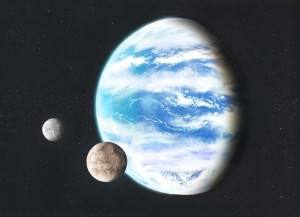16 December 2014
Scientists trying to create “exoplanet zoo”
Posted by kwheeling
By Chris Cesare

Exoplanets, like the stars they orbit, come in many shapes and sizes. But in terms of habitability, the best candidates might bear a striking resemblance to Earth–at least on the surface.
Credit: Lucianomendez under Creative Commons Attribution-Share Alike
Scientists are working to simulate and catalogue the properties of Earth-like planets to create an “exoplanet zoo,”—a collection of worlds with similar compositions but different levels of habitability.
That’s the goal of a new modeling approach presented by Cayman Unterborn during a poster session Monday morning at the American Geophysical Union’s Fall Meeting in San Francisco.
Unterborn, a doctoral student at The Ohio State University, and his colleagues used computer models to predict the structure and mineral makeup of planets with different relative amounts of magnesium and silicon, two crucial components of the Earth’s own rocky mantle. Those minerals are an important part of habitability, Unterborn said, as they determine how heat can flow in the mantle and drive convection, the transport of heat by moving material.
“Whether or not you have water on the surface won’t matter if you don’t have mantle convection,” he said.
The properties of the mantle, which sits between the Earth’s crust and the planet’s core, play a big part in ensuring that there is water on the surface of the Earth. That’s because the mantle can store hydrogen, a component of water, for long periods of time and then reintroduce it later into the Earth’s oceans.
As water evaporates, radiation in the atmosphere can split it apart into hydrogen and oxygen. Hydrogen, the lightest element in the universe, then floats away into space, never to return. Without the hydrogen stored in the mantle, the Earth would have lost all its water long ago.
“The mantle kind of acts like a savings account for water,” Unterborn said.
But if the mantle is too stiff, this water recycling can’t happen. The mantle needs to be soft enough to allow heat inside the Earth to drive convection, which is ultimately responsible for the way pieces of the Earth’s crust, called plates, move over time. It’s the movement of these plates that traps hydrogen in mantle.
In the team’s model, the amounts of magnesium and silicon affected the abundance of two minerals that make up much of the Earth’s mantle and determine its stiffness. More magnesium led to more ferropericlase, a softer mineral, while more silicon led to more bridgmanite, which is stiffer. These results show that even exoplanets that could support liquid water by virtue of being the right distance from their own sun might not be habitable due to their composition.
It’s these differing amounts of elements that are responsible for each “species” in the exoplanet zoo.
The team has more ambitious plans for their model. They want to use observations of distant stars to characterize the chances that habitable planets could form around them. By leveraging the fact that stars and their planets tend to have similar amounts of elements like magnesium and silicon, they plan to first model the kinds of planets that might form around a given star, and then model their mineral properties.
“The goal is to look at a star that has planets around and ask what a habitable planet looks like,” Unterborn said.
It’s a search for habitable planets, but also an attempt to find out more about the Earth by studying planets that are rocky but with slightly different amounts of common elements.
As Unterborn asked, “Is the Earth special?”
Chris Cesare is a science communication graduate student at UC Santa Cruz.










 GeoSpace is a blog on Earth and space science, managed by AGU’s Public Information staff. The blog features posts by AGU writers and guest contributors on all sorts of relevant science topics, but with a focus on new research and geo and space sciences-related stories that are currently in the news.
GeoSpace is a blog on Earth and space science, managed by AGU’s Public Information staff. The blog features posts by AGU writers and guest contributors on all sorts of relevant science topics, but with a focus on new research and geo and space sciences-related stories that are currently in the news.